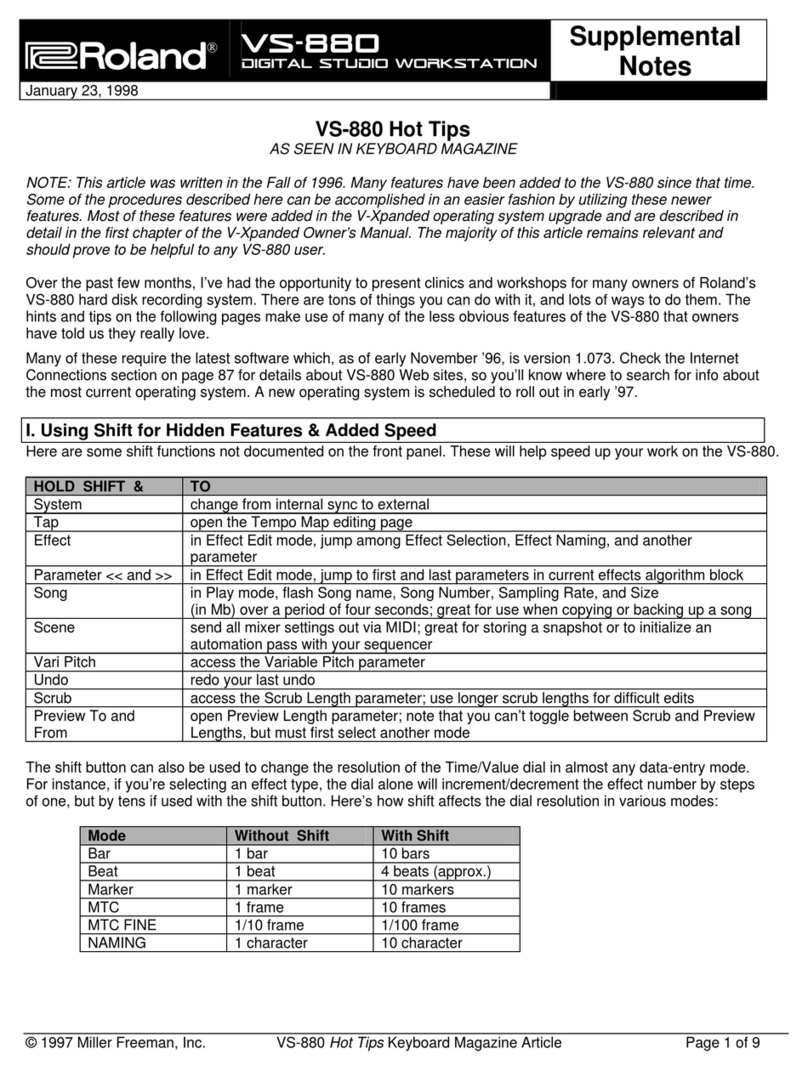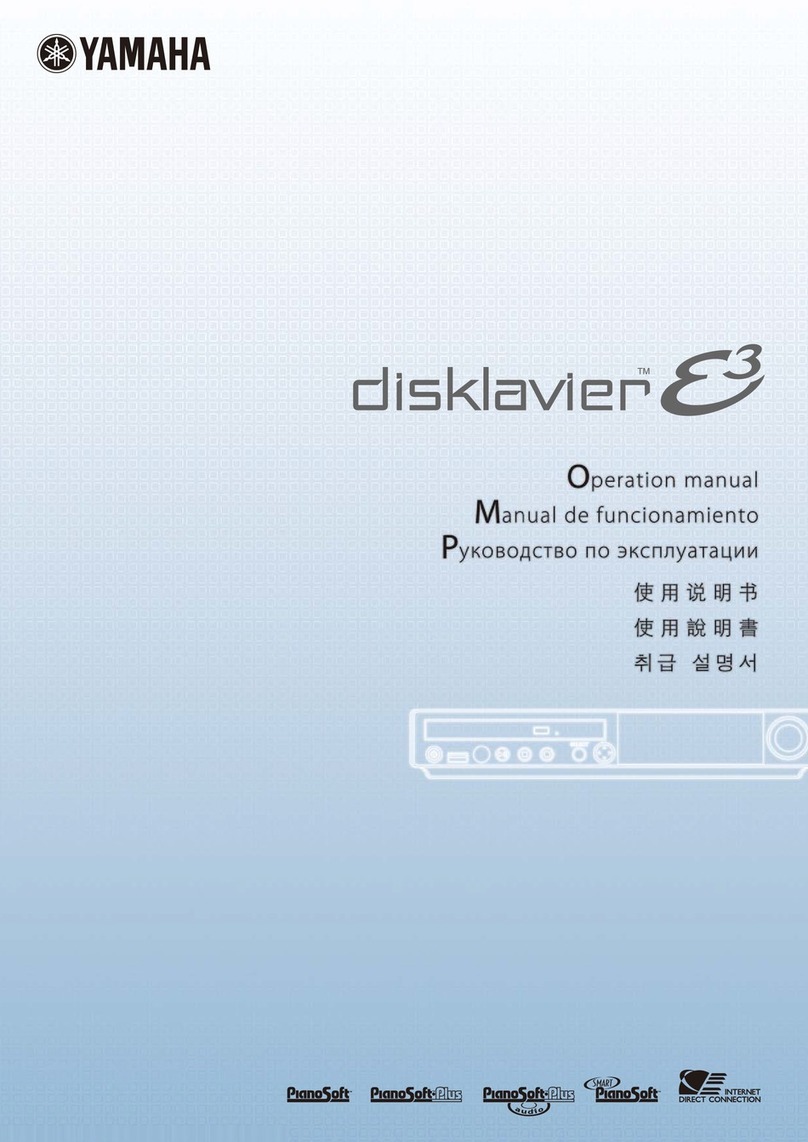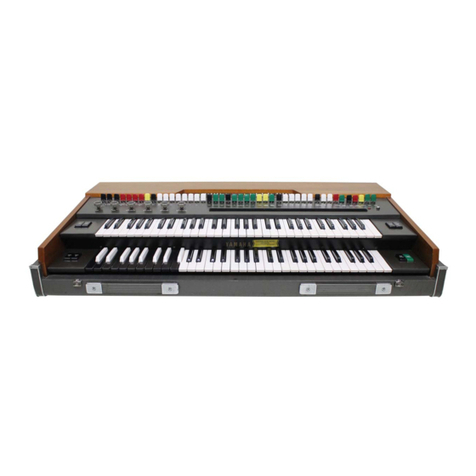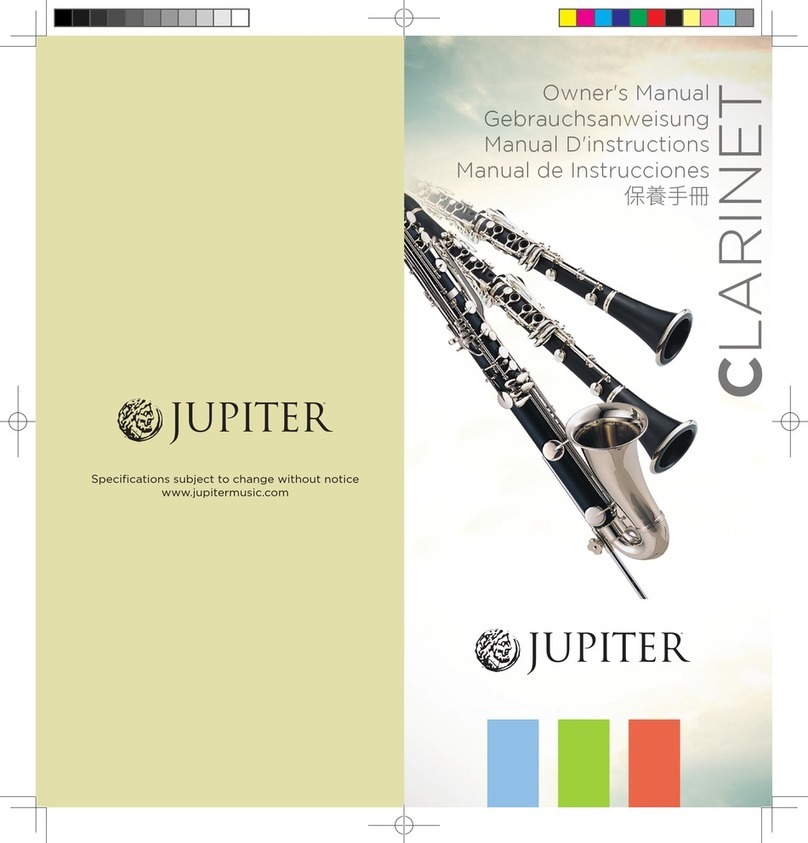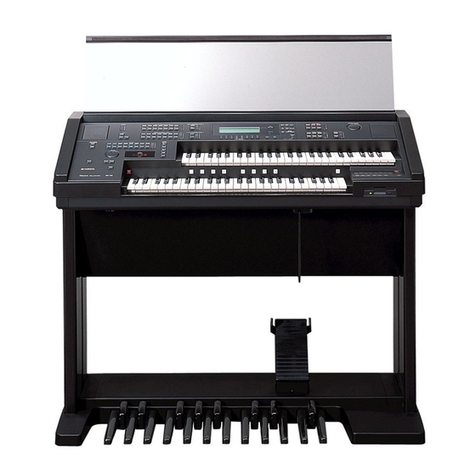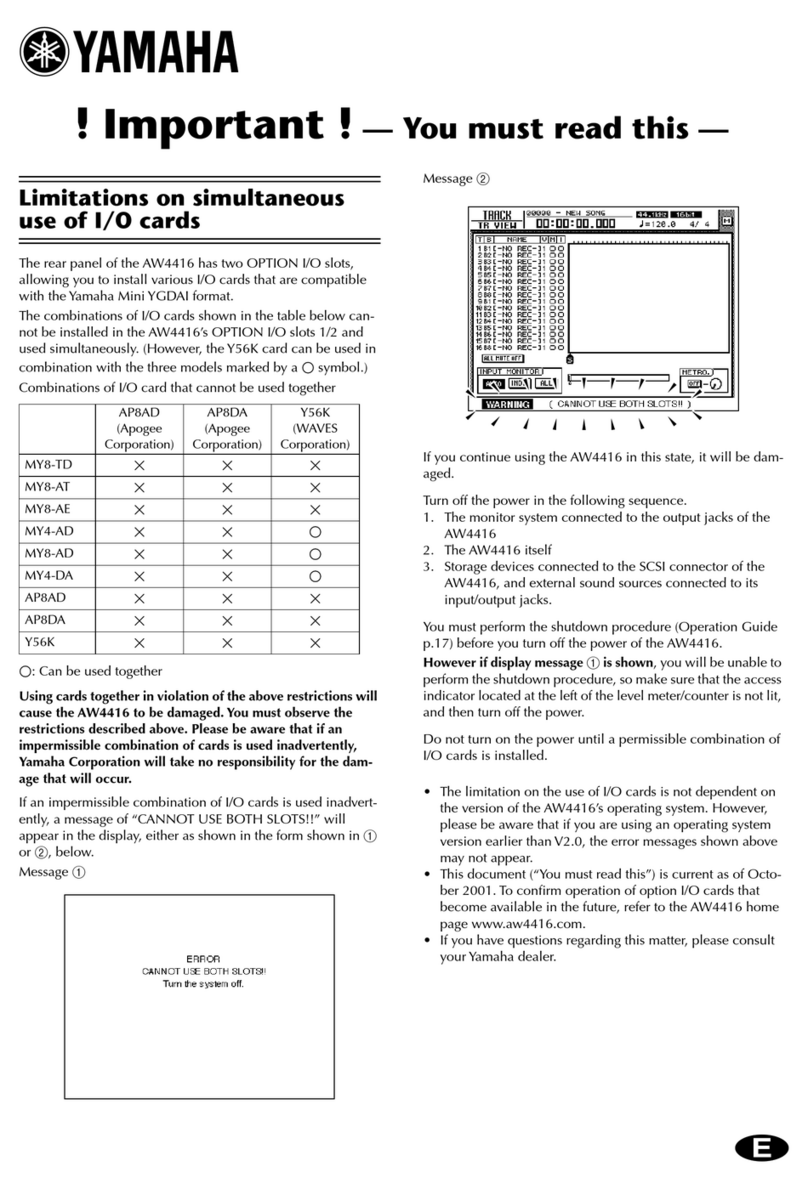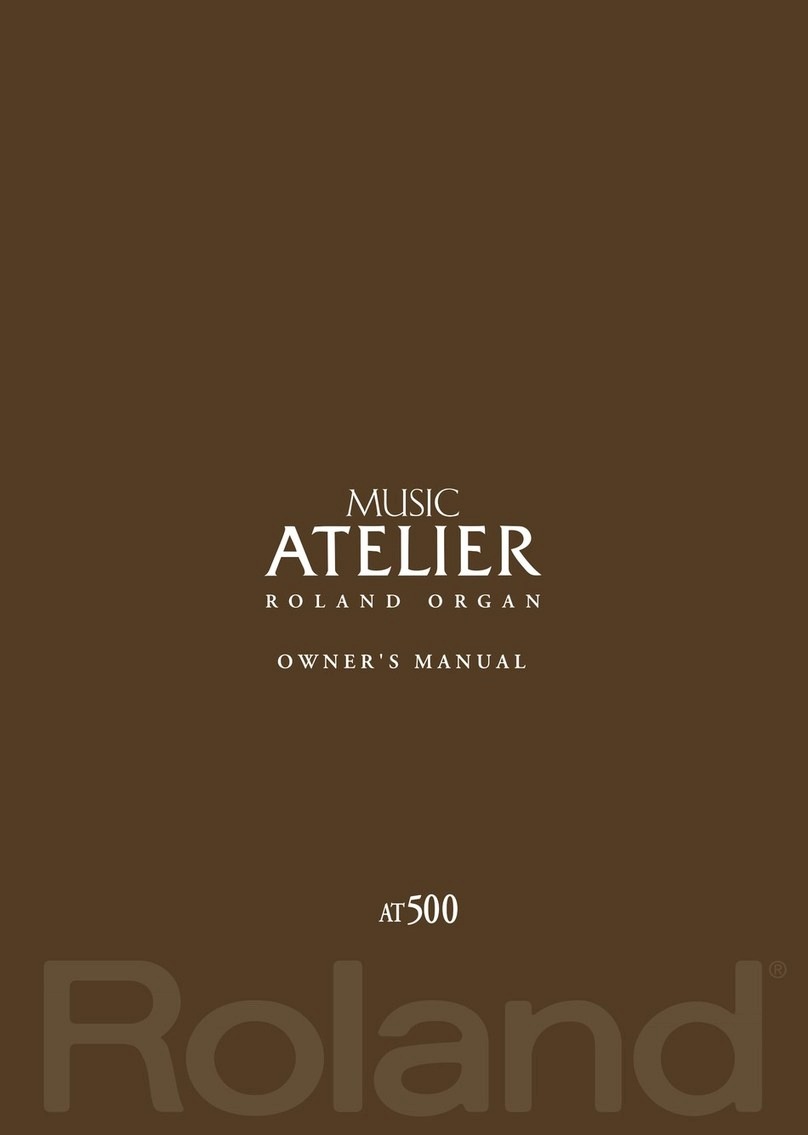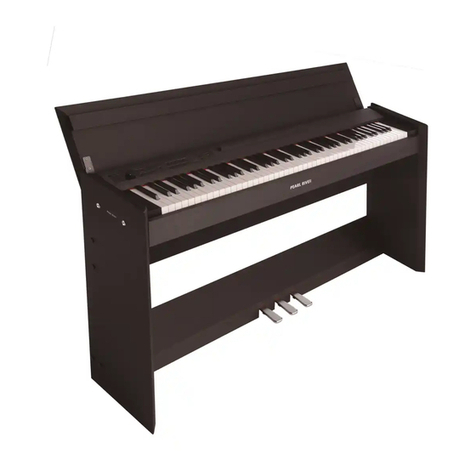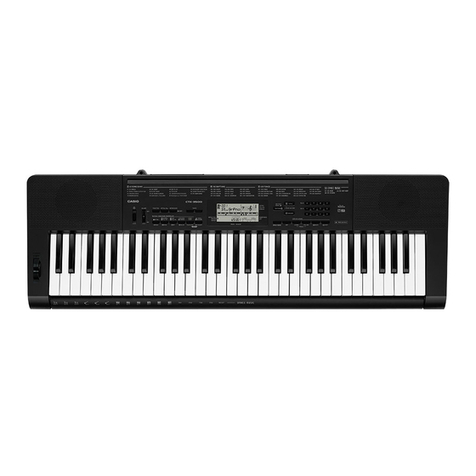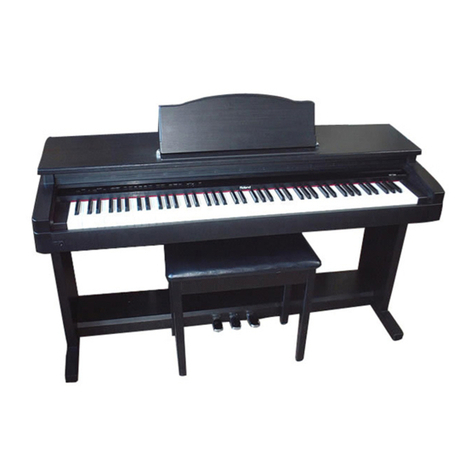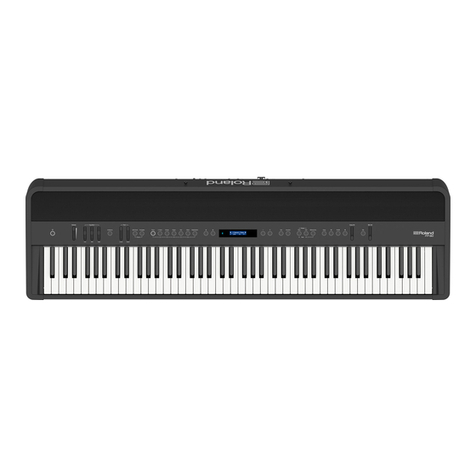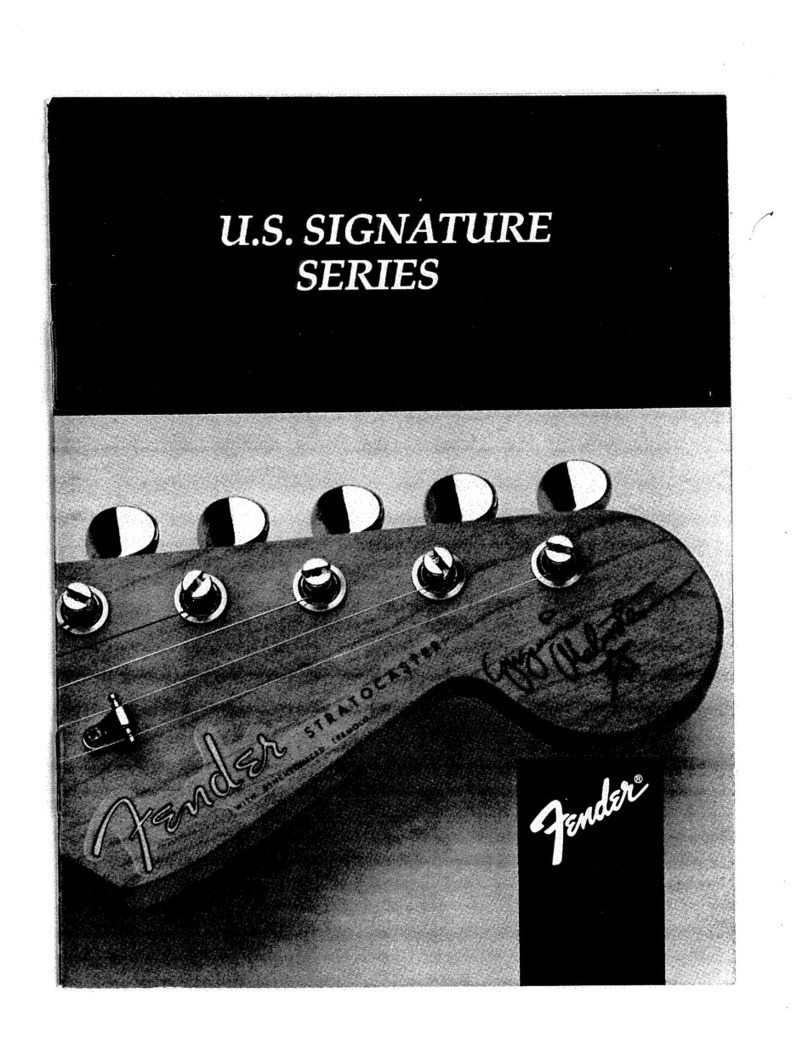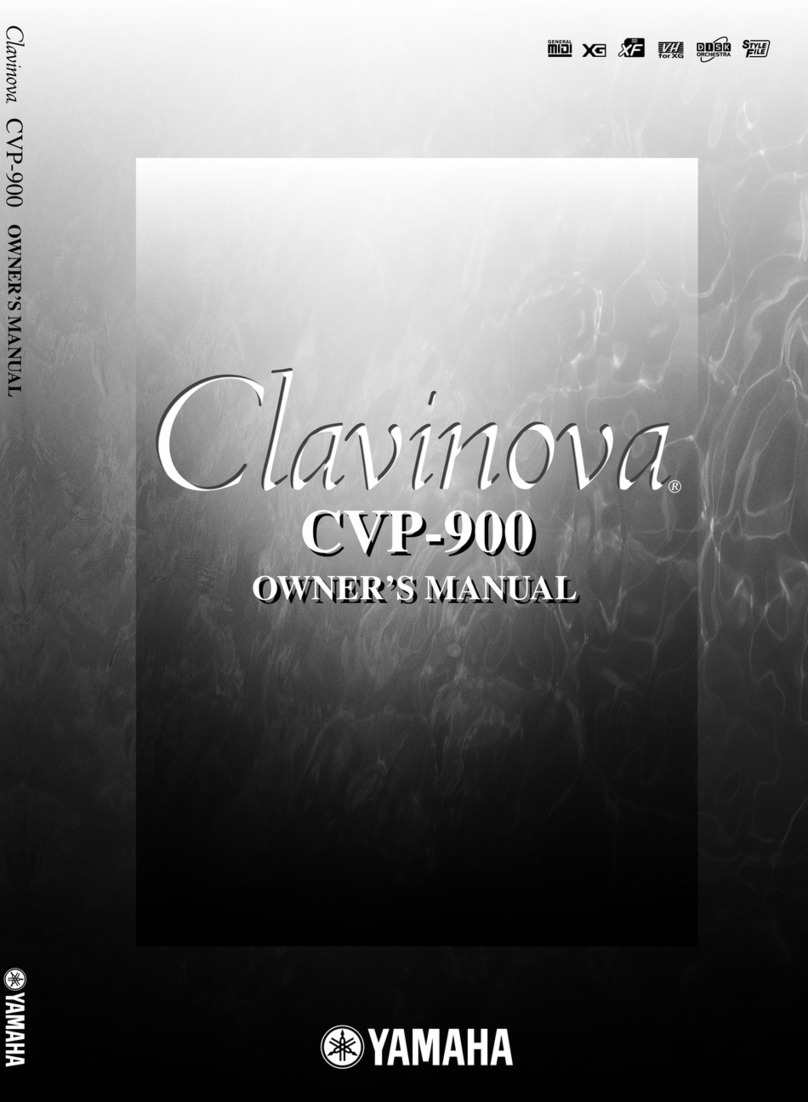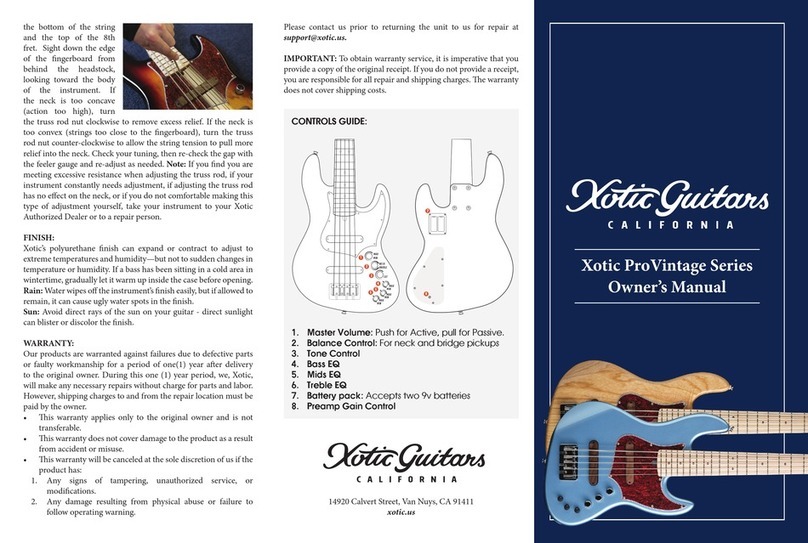Crumar MOJO 61 User manual

MOJO 61
USER'S MANUAL
Firmware version 1.1
www.Crumar.it
CRUMAR MOJO 61 USER'S MANUAL - Page 1/28

CRUMAR MOJO 61 USER'S MANUAL - Page 2/28

Congratulations! You are now the lucky owner of a Crumar Mojo 61, one of the
finest digital key oards of the modern era. The Mojo 61 is a high quality instrument that
was entirely conceived, developed and uilt in Italy with premium quality parts. This
instrument is the the result of years of research in sound design, quality electronics and
has een assem led with first class craftsmanship. We wish you many years of enjoyment
and good music with your new Mojo 61, and, if we may give you a small piece of advice...
you guessed it... please read this manual in its entirety and keep it in a safe place for future
reference! Have fun!
The Crumar Gang.
SAFETY INFORMATION
–Do not open the inst ument. The inst ument can be opened and epai ed only
by qualified pe sonnel. Unautho ized opening voids the wa anty.
–Do not expose the inst ument to ain o moistu e.
–Do not expose the inst ument to di ect sunlight.
–Be ca eful not to infilt ate powde s and liquids inside the inst ument. No on
the outside.
–If liquids get inside the unit, emove the powe immediately to p event the isk
of elect ic shock and contact a se vice cente as soon as possible.
–Do not clean using ab asive cleane s as they may damage the su face.
–Please keep all packaging in case you need to t anspo t the inst ument to a
se vice cente .
–The supplied powe adapte can be used in any Count y that has a mains
voltage between 100 Vac and 240 Vac. Please use only the supplied PSU.
–Do not touch the AC adapte with wet hands.
WARRANTY
–C uma Mojo 61 is subject to 12 months manufactu e 's wa anty.
–Wa anty extensions a e at the disc etion of the etaile .
–Damages caused by misuse, imp ope maintenance o t anspo tation a e not
cove ed by this wa anty.
–Du ing the wa anty pe iod, the custome is entitled to epai o eplacement
of any pa ts conside ed defective at no cha ge.
–The possible eplacement of the enti e p oduct is at the manufactu e 's
disc etion.
CRUMAR MOJO 61 USER'S MANUAL - Page 3/28

CHAPTER SUMMARY:
1. The sounds of Mojo 61 p. 5
2. The effects p. 7
3. The command panel pa t 1 p. 8
4. The command panel pa t 2 p. 9
5. The command panel pa t 3 p. 10
6. The ea panel p. 11
7. Connecting cont ol accesso ies p. 12
8. How to tu n the Mojo 61 on p. 12
9. All about VB3 p. 13
10. Playing the Pipe O gan p. 16
11. Combo O gans p. 17
12. Elect ic Piano p. 18
13. Applying effects to Combo O gans and Elect ic Pianos p. 19
14. The SHIFT button and the alte nate functions p. 19
15. Connecting to the Wi-Fi Edito p. 20
16. Using the Edito Web-App p. 21
17. Sho tcuts p. 23
18. The USB po ts p. 23
19. MIDI Functions and implementation cha t p. 24
20. MIDI Map p. 25
21. Specifications p. 26
CONVENTIONS USE IN THIS MANUAL
Eve y time a button, an LED o any othe cont ol is efe enced, it is done by the
numbe that has been associated to it in the d awings found in chapte s 3 to 8. When
you' e invited to “p ess & hold” a button, it is intended that the button should be kept
dep essed fo at least 2 seconds.
You will find that some concepts might be epeated mo e than once, this happens
because the e could be a mention in a chapte , and a detailed explication in a late
chapte .
We ecommend you to ead this manual with the inst ument in f ont of you, so you
can put into p actice what you a e eading and you can have an instant feedback of
the notions he e explained.
CRUMAR MOJO 61 USER'S MANUAL - Page 4/28

1. THE SOUN S OF MOJO 61
VB3-II virtual tonewheel organ
This is the exact same softwa e that powe s the C uma Mojo and
p esents the same pa amete set. VB3-II is the esult of 12 yea s of
study, esea ch, expe imentation and development of the simulation
of a vintage Hammond B3 o gan. It is the evolution of the GSi VB3 1.4
which is still available as a plugin fo digital audio wo kstations. In the
last 5 o 6 yea s it has been conside ed the best simulation of a
tonewheel o gan by some of the most acclaimed jazz and ock
o ganists and o gan techs. The C uma Mojo has been a best-selle in the "Clone
O gan" ma ket du ing 2013 and 2014 and now the new Mojo 61 offe s you the
possibility to take advantage of one of the best clone o gans eve without
comp omises.
Pipe Organ
A pipe o gan is not something you see eve y day, the e a e
thousands of diffe ent pipe o gans that diffe by the numbe of
stops, the numbe of manuals, the numbe and the type of pipes,
thei size, thei position, etc. but we wanted to keep it simple and
offe a pipe o gan that would be easy to unde stand and inspi ing to
play, so we chose to offe a Ba oque-style o gan based on a single
manual and 9 stops plus 3 couple s and the classic "t emulant" effect.
This synth engine wo ks as an hyb id synthesize , uses additive synthesis and
physical modeling, the e a e no samples involved. The exp ession pedal esponds
natu ally and va ies the amount of ai that passes th ough the pipes. The e is a total
of 776 vi tual pipes.
Combo Organs
The Mojo 61 featu es two simulations of ve y famous Italian
t ansisto o gans of the seventies, the VOX Continental and the
Fa fisa Compact DeLuxe. Each of these o gans is simulated in eve y
detail, ep oducing the essence and the exact colo of that g itty
o gan sound that was the co ne stone of ock bands like the Doo s,
the Pink Floyd and simila . The polyphony is full (all 61 notes at the
same time) and all cont ols behave exactly like in the o iginal
inst ument. One note: since both these o gans we e o iginally based on 49-note
keyboa ds, we chose to b ing the pedalboa d tones to the fi st octave. The
pedalboa d tone has no settings.
CRUMAR MOJO 61 USER'S MANUAL - Page 5/28

Tines Electric Piano
The e's no keyboa dist without a good Rhodes elect ic piano sound.
And the Mojo 61 offe s what can be conside ed the best fusion
between sound fidelity and playability. This synth engine is based on
mo e than 10 yea s of expe ience on the physical modeling
simulation of a Rhodes elect ic piano, eve ything in the "body" of
each single note f om the attack t ansient to the ve y last decay is
pu ely simulated. Some mino elements a e added f om selected
sampled sou ces, but the most impo tant pa t of the sound is pu e synthesis. Eve y
element of the mechanical piano is vi tually econst ucted in the Mojo 61, f om the
hamme , the hamme -tips, the tines, the toneba s, the pick-ups, the dampe s, the
output filte st aight to the output jack, and they all behave exactly like in the eal
thing. Each of the 88 notes is simulated individually, and each note is a gene ato on
its own, thus offe ing the full polyphony, no note stealing and a ve y natu al and t ue
to the o iginal behavio . Plus, this new simulation featu es a ve y ealistic
sympathetic esonance that involves the whole "ha p" that can vib ate and esonate
eve y time a key is st uck. It is eally ha d to tell the Mojo simulation f om a eal
Rhodes piano, the level of ealism and the numbe of details is ve y high.
Reed Electric Piano
Simila ly to the p evious inst ument, the simulation of a Wu litze
200A elect ic piano is totally based on physical modeling with only a
mino addition of sampled mate ial. Same technique as befo e, eve y
pa t of the mechanical piano is vi tually ep oduced in o de to
obtain the maximum level of ealism and playability, including the
sympathetic esonance. This piano has 64 notes and all of them can
play at the same time.
PM Electric Piano
One of the most used elect ic piano sounds du ing the eighties was
the famous patch "E-PIANO 1" of the Yamaha DX7. The Mojo 61 offe s
a ep oduction of that ve y patch using the same "Phase Modulation"
synthesis, thus the esult is exactly the same as the o iginal
inst ument, no comp omise. This synthesize has a 24-voice
polyphony with ou "Intelligent Note Stealing Algo ithm" that steals
only quiete notes and not those being still held, making the
polyphony limit not a p oblem.
Sampled Acoustic Grand Piano
This sample-set comes f om the facto y sample lib a y of the GSi Gemini and is based
on the GSP-01 "Adaptive Sample Playe " synthesis engine. It featu es a special
"Physical Modeling Piano Ha p Resonance Simulato " that adds natu al esonances to
the sound mimicking the behavio of a eal piano ha p.
CRUMAR MOJO 61 USER'S MANUAL - Page 6/28

2. THE EFFECTS
Tremolo / Auto-panner
Mojo 61 offe s elect ic pianos and o gans, so how could we miss such an impo tant
effect in the chain? It is a must in mono mode when combined with the Reed EP,
sounds g eat in squa e ste eo with the Tines EP.
Stereo Phaser
This is a 4-stage ste eo phase (two individual phase s slightly shifted), and offe s
pa amete s such as LFO speed and depth. Sounds g eat on the elect ic piano sounds.
Stereo Chorus
We've been listening to a selection of cho us effects fo keyboa ds and guita s,
anging f om the ea ly analog BBD cho uses up to the mode n digital ones, but one
that wo ks eally g eat on a vast va iety of sounds is the two-voice BBD-based ste eo
cho us that Roland included in the RD-1000 and in many othe s of thei inst uments
of the eighties. This is a simulation of that ve y cho us and sounds eally g eat with
the elect ic pianos.
Amp Simulator
And he e comes the boutique amp collection. This p ocesso simulates five among
the most used guita and bass amps of all times: the Fende Twin, the Ma shall JCM-
800, the Vox AC30, the Roland Jazz Cho us and the Fende BassMan. Each amp
featu es a 3-way equalize and an adjustable ove d ive.
Rotary Effect Simulator
The e's no VB3-II without a g eat ota y effect. This is the exact same ota y effect
featu ed in the C uma Mojo, offe ing the same cont ol set and the same sound.
igital Reverb
This is a g eat sounding digital eve b that b ings light and ai to you sound. Sounds
soft, smooth and deep, p ecise and alive, ai y and so much ealistic that's a eal joy to
have some in the mix.
Equalizer
This section contains a ve y basic 3-band equalize . Use it to shape you sound fo a
pe fect match with you amplification system.
CRUMAR MOJO 61 USER'S MANUAL - Page 7/28

3. THE COMMAN PANEL – part 1
In this chapte we get familia with the command panel of the Mojo 61; fo a bette
eadability, the panel has been split into th ee pa ts. Numbe s a e used to efe ence
to each cont ol late in this manual.
1. Volume knob.
2. D ive knob, adjusts the ove d ive level when the Rota y Speake effect is active
on VB3 and when a Static Amp is active on Combo o gans o Elect ic Pianos.
3. RUN/STOP: p ess to stop the otation of the Rota y Speake effect, the
co esponding LED will tu n on; p ess again to e-sta t the otation, the LED will
go off.
4. SLOW/FAST: p ess to switch between the two speeds of the Rota y Speake
effect. The co esponding LED animates acco dingly. Please note that the LED
animation is not synch onized with the sound, it's only the e fo a bette visual
feedback. When the STOP speed is engaged, the LED animation halts.
Dep essing this button while in STOP mode will switch the speed and the LED
will sta t animating again, even though the e will be no effect on the sound until
the STOP is disengaged using button n. 3.
5. This LED indicates that the suppo t fo the optional “Half-Moon” switch has been
enabled, in this case buttons 3 and 4 a e un esponsive. To enable and disable the
“Half-Moon” suppo t, p ess buttons 3 and 4 togethe .
6. P ess this button to switch cyclically between the Vib ato/Cho us options. When
playing VB3, the e a e 6 options (C1, C2, C3, V1, V2, V3); when playing the Combo
o gan “Compact DeLuxe” , only 4 options a e available (labeled with smalle
cha acte s, explained late ).
7. This button enables/disables the Vib ato/Cho us effect on the selected manual.
CRUMAR MOJO 61 USER'S MANUAL - Page 8/28
Fig. 1 - Command Panel part 1

4. THE COMMAN PANEL – part 2
8. P esets fo the uppe manual.
9. Uppe manual selecto / Uppe HOLD function.
10. The d awba s. These a e used fo all o gan sounds the Mojo 61 offe s.
11. P esets fo the lowe manual.
12. Lowe manual selecto / Lowe HOLD function.
13. This LED indicates the status of the “Pedal-to-lowe ” function that can be
enabled and disabled by p essing button n. 14 and then button n. 12.
14. Pedalboa d selecto .
15. MODE selecto . P ess to switch between SINGLE and SPLIT, p ess and hold to
activate the EXT-LOWER mode.
CRUMAR MOJO 61 USER'S MANUAL - Page 9/28
Fig. 2 - Command Panel part 2

5. THE COMMAN PANEL – part 3
16. Knobs fo adjusting the Reve b level and the amount of key-click p oduced by
VB3 and the Combo o gans.
17. Equalize section, wo ks on top of eve ything.
18. Multi-function button n. 1.
19. Multi-function button n. 2.
20. Multi-function button n. 3.
21. Multi-function button n. 4.
22. Inst ument type selection. P ess this button to cycle between the fou basic
sounds (VB3, Pipe o gan, Combo o gan, Elect ic piano) f om top to bottom.
P essing this button along with the SHIFT button cycles f om bottom to top.
23. This LED indicates whethe the t ansposition has been enabled.
24. This LED indicates the status of the Rota y Speake effect o the Static amps.
25. This LED indicates whethe the LOCAL-OFF function has been enabled. In a
no mal playing situation this LED should be off.
26. The SHIFT button. It is used in conjunction with othe buttons fo alte nate
functions and sho tcuts that will be explained late in this manual.
CRUMAR MOJO 61 USER'S MANUAL - Page 10/28
Fig. 3 - Command Panel part 3

6. THE REAR PANEL
1. Analog, line level, balanced, ste eo audio output. Use you jack co ds to connect
the Mojo 61 to you amplification system. P efe ably, use balanced cables.
2. Output level selection. The optimal choice is to leave this selecto in the middle
position (+4 dB); if you' e connecting it to a home “consume type” hi-fi system,
use the “L” position (-10 dB); fo mo e powe use the “H” position.
3. Headphone output, max load = 32 ohm (check with you headphone specs).
Best pe fo mance with studio g ade 55 ohm headphones.
4. If you fo got you Wi-Fi passwo d fo accessing the Edito web-app, use a small
sc ewd ive o a sha p pencil to push the button that hides behind this hole. The
passwo d will be e-set to “00000000” and the system will esta t automatically.
5. System USB 2.0 Type “A“ po t, used fo fi mwa e updates and othe connections.
6. These a e two MIDI inputs inte nally me ged togethe . If you want to connect an
exte nal keyboa d to cont ol you Mojo 61, just pick one of the two, they' e
identical. The e a e two because you might also want to connect a pedalboa d,
so you don't need an exte nal MIDI Me ge unit.
7. You Mojo 61 can also be used to cont ol othe MIDI equipment, this is the usual
MIDI output socket.
8. Class-compliant USB-MIDI IN/OUT po t, can be used to connect the Mojo 61 to
you compute without using an exte nal MIDI inte face.
CRUMAR MOJO 61 USER'S MANUAL - Page 11/28
Fig. 4 - Back panel part 1.
Fig. 5 - Back panel part 2.

7. CONNECTING CONTROL ACCESSORIES
The e a e th ee additional Jack sockets on the back of the Mojo 61 that a e used to
connect pedals o the “half-moon” 3-way switch.
9. Half-Moon o Foot Switch input socket. He e you can connect ou dual foot
switch o ou half-moon switch; the latte can only be attached to the optional
lowe manual keyboa d, and is activated by pushing buttons n. 3 and n. 4
togethe . No mally, this socket accepts the dual foot switch that wo ks
concu ently with the panel buttons n. 3 and n. 4. Please make sure to use a foot
switch specifically made for the Mojo 61.
10. Connect a 10-K ohm exp ession pedal to this jack; ou C uma long-th ow pedal
is the pe fect choice, but othe thi d pa ty pedals might be compatible as well.
11. Connect a t aditional sustain pedal to this jack; the pola ity is automatically
detected when the inst ument is powe ed on, so please make su e that the
pedal is al eady connected befo e powe ing on.
ABOUT THE SUSTAIN PEDAL
The sustain pedal is no mally used when the Elect ic Piano sound is active and
functions as a no mal piano sustain pedal. Howeve , when VB3 is active and the
Rota y Speake effect is on, the sustain pedal can be used to switch between SLOW
and FAST speeds; when the speed is set to STOP by using button n. 3, the sustain
pedal can be used to deactivate the ota y b ake and etu n to the p evious speed.
8. HOW TO TURN THE MOJO 61 ON
You should have been given an exte nal PSU (Powe Supply Unit),
one end goes to the powe outlet, the othe end goes to the powe
socket on the back of you Mojo, labeled with numbe 12.
Push the switch n. 13, afte a second you will see all the lights
illuminating the cont ol panel, and afte 8 mo e seconds the
inst ument is eady to be played.
CRUMAR MOJO 61 USER'S MANUAL - Page 12/28
Fig. 6 - Pedal inputs.
Fig. 7 – Po er section.

9. ALL ABOUT VB3
VB3 is the fi st inst ument that can be selected by pushing the button n. 22 labeled
TYPE. It is the simulation of a tonewheel o gan and is the main sound engine of you
C uma Mojo 61. Just like the o iginal o gan, it consists of th ee manuals, the uppe ,
the lowe and the pedalboa d, even though we have only one physical keyboa d and
one set of 9 d awba s. Neve theless, Mojo 61 offe s some sma t solutions to make it
fun and easy to play even without the additional lowe keyboa d.
Fi st, select which MODE you wish to play by using button n. 15. It is ve y impo tant,
because the MODE establishes which manual the keyboa d plays and which manual
the d awba s must cont ol.
Second, select which manual you' e going to play and/o to cont ol, by using the
buttons n. 9 fo the uppe manual, button n. 12 fo the lowe manual, button n. 14 fo
the pedalboa d.
Now an example is given in o de to explain how diffe ent modes wo k. Let's assume
that the uppe manual is selected.
–MODE = SINGLE: the keyboa d plays the uppe manual and the d awba s
cont ol the uppe manual egist ation;
–MODE = SPLIT: the keyboa d is split in two pa ts, the left pa t plays the lowe
manual, the ight pa t plays the uppe manual; the d awba s cont ol the uppe
manual (which, in this example, is selected); if we select the lowe manual, the
keyboa d emains split but the d awba s will now cont ol the lowe manual;
–MODE = EXT. LOWER: the keyboa d always cont ols the uppe manual, the
d awba s will cont ol the manual that is cu ently selected. This is because the
lowe manual is expected to be played f om an exte nal MIDI keyboa d.
The playa le extension of the VB3 organ is 61 notes, from C (note 36) to C
(note 96). Applying the transposition would not affect the playa le
extension, thus resulting in having mute notes at one of the extremes of the
key oard.
CHORUS / VIBRATO
VB3 suppo ts the 6 selections of Cho us o Vib ato, just like the o iginal tonewheel
o gans, and sepa ate activation on the uppe manual and/o the lowe manual (that
also includes the pedalboa d) by using only one button. When the uppe manual is
selected, button n. 7 and its LED elate to the uppe manual; when the lowe manual
o the pedalboa d is selected, button n. 7 wo ks on the lowe manual. Of cou se the
status (on o off ) is emembe ed. Shortcut: use utton n. 7 along with the SHIFT utton
to toggle the effect on the other manual.
CRUMAR MOJO 61 USER'S MANUAL - Page 13/28

DRAWBARS
We assume you al eady know what d awba s a e and how they affect the sound of a
tonewheel o gan. If you don't, we invite you to sea ch the web and ead one of many
documents that explain how tonewheel o gans wo k. Ou sole intention, in this
chapte , is to explain that the 9 d awba s can wo k fo both the uppe manual and
the lowe manual, and the fi st 3 wo k fo the pedalboa d.
Have a look at figu e 8. The ow labeled “VB3” indicates the pitch of each d awba ; the
ow labeled “TW-BASS” indicates that the fi st d awba adjusts the 16' of the
pedalboa d, the second d awba adjusts the 8' and the thi d d awba adjusts the
elease time (simulation of the “st ing bass” function). Of cou se, in o de to have
d awba s adjusting the pedalboa d, you have to select the pedalboa d by pushing
button n. 14. Don't forget, first make sure which manual you have selected, then move
the draw ars.
Despite the printed digits from 1 to 8 and the 15 “clicks” that you feel when
moving the draw ars, they actually send 128 MIDI values from 0 to 127.
Draw ars are just like normal slider pots, only with the shape and the look
of organ draw ars.
DRAWBAR PRESETS
Each manual (uppe and lowe ) suppo ts two “d awba p esets”; uppe manual uses
buttons 8A and 8B, lowe manual uses buttons 11A and 11B. They wo k just like the
eve sed colo keys of a console tonewheel o gan, exactly the same way. They only
sto e the values of the d awba s. When a p eset is activated, moving the d awba s
won't make any change to the sound; when a p eset is activated on the uppe
manual, the pe cussion is disabled; to e-enable the d awba s, just e-select the
manual you wish to cont ol.
How to save a drawbar preset: select the desi ed manual, set the d awba s in the
desi ed position, p ess and hold the desi ed p eset button. You'll see the LED quickly
blinking only once, indicating the end of the p ocess.
CRUMAR MOJO 61 USER'S MANUAL - Page 14/28
Fig. 8 - Dra bar function table.

THE HOLD FUNCTION
P obably you've noticed that, next to the labels “Uppe ” and “Lowe ”, the e's a smalle
label that eads “HOLD”. This is a special function that, when activated, momenta ily
disconnects the d awba s f om the sound, allowing you to adjust the d awba s
without affecting the sound, and get instantly to the new egist ation, as if it we e a
sto ed p eset, the exact moment you deactivate the HOLD function.
Example: select the uppe manual, set the d awba s the way you like and play a
cho d; now p ess the uppe manual selection button again (button n. 9), you'll notice
that the co esponding LED sta ts flashing; now move the d awba s to a new
egist ation while still keeping the cho d playing... hea , nothing changes to the
sound; now push the HOLD button again. The new egist ation is now playing.
This is p etty much what o ganists use to do with console o gans that have two
d awba sets pe each manual.
PEDALS TO LOWER
To activate o deactivate this function, fi st p ess and hold the pedalboa d selection
button n. 14 and then p ess lowe selection button n. 12. The yellow LED n. 13 stays
on if this function is enabled.
This function makes it possible to play the pedalboa d tones along with the lowe
manual, one stacked on top of the othe , with the diffe ence that the lowe manual
will play ac oss the whole keyboa d, while the pedalboa d will only play ac oss the
lowe 25 notes.
PERCUSSION
It's a sho t, pe cussive sound that's added on top of the
d awba sound with the aim to einfo ce the attack
t ansient, adds something special to the o gan sound.
–Button n. 18: Tu ns the pe cussion on o off. Please
note that the pe cussion only wo ks on the uppe
manual and, when activated, disables the sound of the
last d awba , exactly like in the o iginal tonewheel
o gan.
–Button n. 19: if activated, the pe cussion volume is “soft”; othe wise it's loude .
–Button n. 20: selects the pe cussion decay time, a sho t (fast) decay when it's
on, o a longe (slow) decay when it's off.
–Button n. 21: selects the ha monic used fo the pe cussion sound, the thi d
ha monic (d awba n. 5) when it's on, second ha monic (d awba n. 4) when off.
CRUMAR MOJO 61 USER'S MANUAL - Page 15/28
Fig. 9 - The percussion buttons.

10. PLAYING THE PIPE ORGAN
P ess the TYPE button n. 22 to shift to the next sound, the Pipe O gan. This is a one
manual o gan with 9 stops, 3 couple s and the t emulant moto . One important thing:
remem er to increase the Rever level a it when playing this sound!
The d awba s, in this case, will function as on/off switches, just like the “stops” of a
eal pipe o gan that can be pushed in (off ) o pulled out (on). The middle position is
the th eshold, and the on/off t ansition is smooth. Eve y stop co esponds to a se ies
of diffe ent pipes, some pipes a e eused on ce tain note anges. Pipes a e o ganized
diffe ently ac oss the ste eo field, most gene ally the lowe pitches a e most audible
on the left channel, and the high pitches a e located mo e towa ds the ight channel.
The Pipe O gan also suppo ts p esets A and B as well as the HOLD function, just like
VB3. Please efe to the p evious chapte .
COUPLERS
The same buttons that we e p eviously used fo the
pe cussion sound with VB3 a e now used fo the so-
called “couple s”, which is a special mechanism of a
pipe o gan that allows a single note to play on
multiple octaves.
Let's make an example: play the cente C-note, now
push button n. 18, this will activate the “SUB OCTAVE”
couple and you'll hea the lowe C adding to the
sound; now push button n. 19 that will activate the
“OCTAVE” couple , so that the highe C will also add
to the sound; lastly, button n. 20 enables the
“CANCEL UNISON” which will cancel the cente note,
i.e. the note that you a e actually playing, leaving only the lowe C and the highe C.
If the “CANCEL UNISON” coupler is ena led and the other two are disa led,
you won't hear any sound. Actually, if you listen closely, you'll hear an airy
attack sound like air that lows through the key and doesn't reach the
pipes. Hey, it's physical modeling, after all!
TREMULANT MOTOR
This is an effect that can be activated using button n. 7. In pipe o gans it's like a
otating vent that p oduces a so t of t emolo effect by alte nating the ai flow
th ough the pipes.
CRUMAR MOJO 61 USER'S MANUAL - Page 16/28
Fig. 10 - Pipe organ stops.
Fig. 11 - Pipe organ couplers.

11. COMBO ORGANS
Back in the seventies many bands that could not affo d an elect o-magnetic
tonewheel o gan used to buy smalle and less expensive t ansisto o gans, mostly
made in Italy. Two of the most famous models a e pe fectly imitated by you Mojo 61.
Use the TYPE button n. 22 to activate the Combo o gan sound. Deciding which
Combo o gan is activated f om the Type button is done via the Edito web-app o a
button sho tcut explained late in this manual.
DRAWBARS
The ow labeled “Combo F” efe s to the “Compact DeLuxe” type. In this case, the
d awba s will act as on/off switches having the middle position as the th eshold.
The ow labeled “Combo V” efe s to the “Continental” type. He e the d awba s act as
no mal d awba s with one exception: the fi st 4 d awba s a e the egiste s, the next
two adjust the volume of the two wavefo ms, the last th ee emain unused. If eithe
the 5th o the 6th d awba s a e not pulled out, the e will be no sound.
VIBRATO
The “Combo F” has 4 diffe ent vib ato types that can be selected
using button n. 6 and can be tu ned on o off using button n. 7.
The fou selections a e labeled as seen in fig. 13 and a e:
–Light Slow
–Light Fast
–Heavy Slow
–Heavy Fast
The “Combo V” has no type selection, just the on-off switch.
CRUMAR MOJO 61 USER'S MANUAL - Page 17/28
Fig. 12 - Dra bars functions hen playing Combo organs.
Fig. 13 - Vibrato
selection for Combo
Organs

12. ELECTRIC PIANO
Push the TYPE button n. 22 to activate the piano and sta t playing a little bit befo e
going on with the eading of this manual.
You will p obably notice that playing the elect ic pianos of the Mojo 61 has a
pa ticula vibe. These a e not the usual samples that you've always found in all digital
keyboa ds since the ea ly 80's, instead, this is a eal-time synthesize that instantly
econst ucts the sound of the elect ic piano while you play it, and you'll feel that it is
alive, it b eathes, eacts to you playing, and behaves just like the eal thing.
The e a e a few things that you can test to p ove that we a e ight. Fi st, the dynamic
esponse. Sampled inst uments have a p edete mined numbe of velocity laye s.
He e the dynamic is p actically infinite, you will ha dly hea twice the same attacks.
The polyphony. The so-called ROMplers usually have a p edete mined numbe of
voices that a e cyclically assigned to the playing notes, and these a e usually mo e
than the playing notes. The elect ic pianos in the Mojo 61 don't need to allocate
ext a voices because they behave just like the eal thing, the e's one moving element
pe key, so 88 playing keys = 88 voices (o 64 fo the eed piano).
If you haven't connected a sustain pedal to you Mojo 61 we invite you do to so now.
Now put you foot on the sustain pedal and keep it dep essed, then play a ri attuto
(keep playing the same note). You will notice some timb al changes due to the fact
that an element is vib ating (a tine o a eed) and the hamme continues to put it into
vib ation, but sometimes the hamme happens to accele ate the vib ation, othe
times it happens to dampen it. Also the attack sound changes eve y time, because
you' e vi tually stimulating something that is al eady moving.
Resonances. An elect ic piano, just like an acoustic piano, has an ha p and a
soundboa d whe e metallic elements a e put into vib ation and, in tu n, t ansmit
thei vib ation to the othe elements. This is called “sympathetic” esonance. T y this:
play a note in the t eble egiste (fo example the last D), now push the sustain pedal
and keep playing that note. You will notice that all othe tines (o eeds) a e put into
vib ation.
The e is mo e, but we a e confident that now you get the pictu e. Now back to the
bo ing technical stuff. Won't you miss the effects?
Switching between the “Tine” and the “Reed” piano is done f om the Edito web-app
but can also be done using a button sho tcut explained late in this manual.
CRUMAR MOJO 61 USER'S MANUAL - Page 18/28

13. APPLYING EFFECTS TO COMBO ORGANS AN ELECTRIC PIANOS
The Multi-function buttons numbe ed 18, 19, 20 and 21 can be used fo accessing
the effects and othe useful functions.
When playing a Combo O gan you can switch FX1 and FX2
by using espectively buttons n. 20 and n. 21. Choosing which
effect is associated to FX1 o to FX2 is done f om the Edito
web-app but can also be done using a button sho tcut
explained late .
When playing an elect ic piano, the octave can be shifted
down o up by using espectively button n. 18 o n. 19. These
buttons a e exclusive, the octave can be eithe down o up. To
eset the octave simply dep ess the active button again.
The status of the effects is always remem ered for
each of the two Com o Organs and each of the four Piano sounds.
Remem ered settings include the on/off status of each effect along with all
their parameter settings made from the we -app editor. To make sure that
settings have een saved, press the active PRESET utton again.
14. THE SHIFT BUTTON AN THE ALTERNATE FUNCTIONS
By pushing the SHIFT button n. 26 along with
buttons 18, 19, 20 and 21 it is possible to access to
othe functions:
–SHIFT + button n. 18: t anspose down by one
semitone. It is possible to get down to -12
semitones.
–SHIFT + button n. 19: t anspose up by one
semitone. The highe limit is +12 semitones.
Note: When the transposition is active, the yellow LED
n. 23 is on.
–SHIFT + button n. 20: tu ns on o off the “Cabinet” simulation which, in case of
VB3, efe s to the Rota y Speake simulato , and in case of Combo O gans o
Elect ic Pianos, efe s to the Static Amp simulato . When the Cabinet simulation
is on, it is possible to adjust the ove d ive amount using knob n. 2.
–SHIFT + button n. 21: this toggles the “Local Off” function that disconnects the
keyboa d f om the inte nal sound gene ato and activates the alte native Tx
Midi Channel as explained late in this manual.
CRUMAR MOJO 61 USER'S MANUAL - Page 19/28
Fig. 14 - Multi-function
buttons for Combo Organs
and Electric Pianos
Fig. 15 - SHIFT functions

15. CONNECTING TO THE WEB-APP E ITOR
Any mode n mobile device (tablets and sma tphones) o any mode n compute
(desktop o laptop) can be used to access the Edito web-app. The execution speed
of the Edito depends on the CPU powe of you device. When the Mojo 61 is on, use
you device's netwo k options to sta t scanning fo existing Wi-Fi netwo ks. The Mojo
61 should cast an SSID that sta ts with "Mojo-xxxxxxxx" whe e the "x" a e eplaced by
an hexadecimal se ial numbe that is unique pe each unit. Complete the connection
using the following passwo d: 00000000 (eight times ze o). The passwo d can be
changed late f om the home sc een of the Edito app and can be esto ed to its
default value at any time by following the p ocedu e desc ibed at page 10, point 4.
Once connected, open you favo ite b owse (Ch ome, Safa i, Fi efox, Edge, etc.) and
type the URL “Mojo/” (the final slash is impo tant, some b owse s might not
ecognize this as a URL) o type the IP numbe 192.168.1.1
The Edito home page should load into you b owse like a no mal web site. This can
be viewed eithe in po t ait o landscape mode, the page should ed aw itself
acco dingly.
The Edito consists of an home page, th ee editing pages fo the sound pa amete s
(VB3, Pianos and Effects), one fu the page fo editing the Midi CC Map, and the
button “Save All” highlighted in ed.
CRUMAR MOJO 61 USER'S MANUAL - Page 20/28
Other manuals for MOJO 61
2
This manual suits for next models
1
Table of contents
Other Crumar Musical Instrument manuals
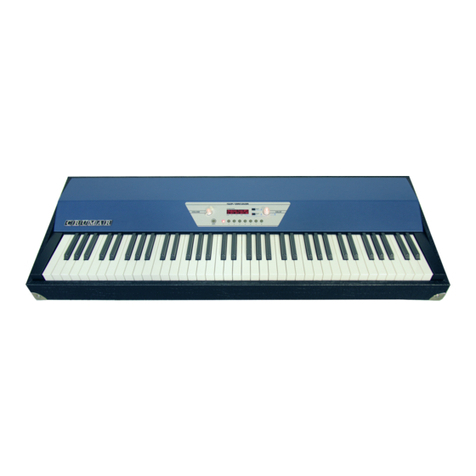
Crumar
Crumar Seventeen User manual

Crumar
Crumar MOJO User manual
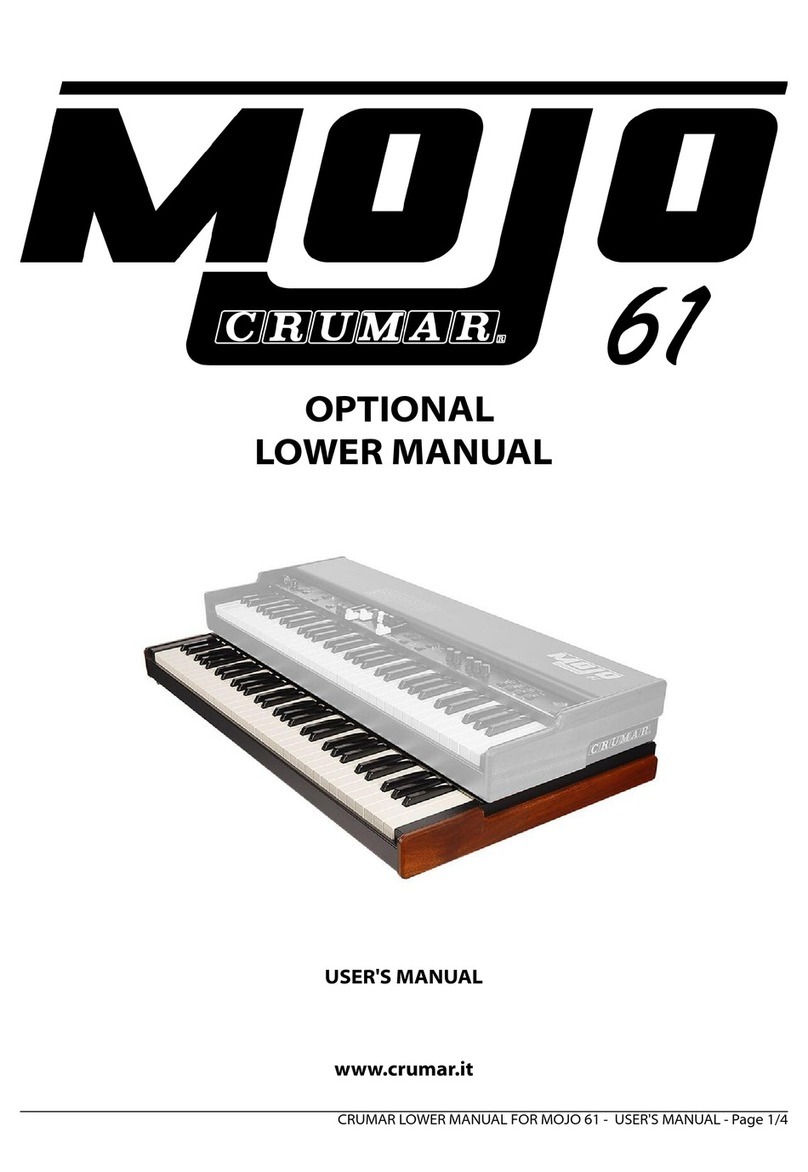
Crumar
Crumar MOJO 61 User manual
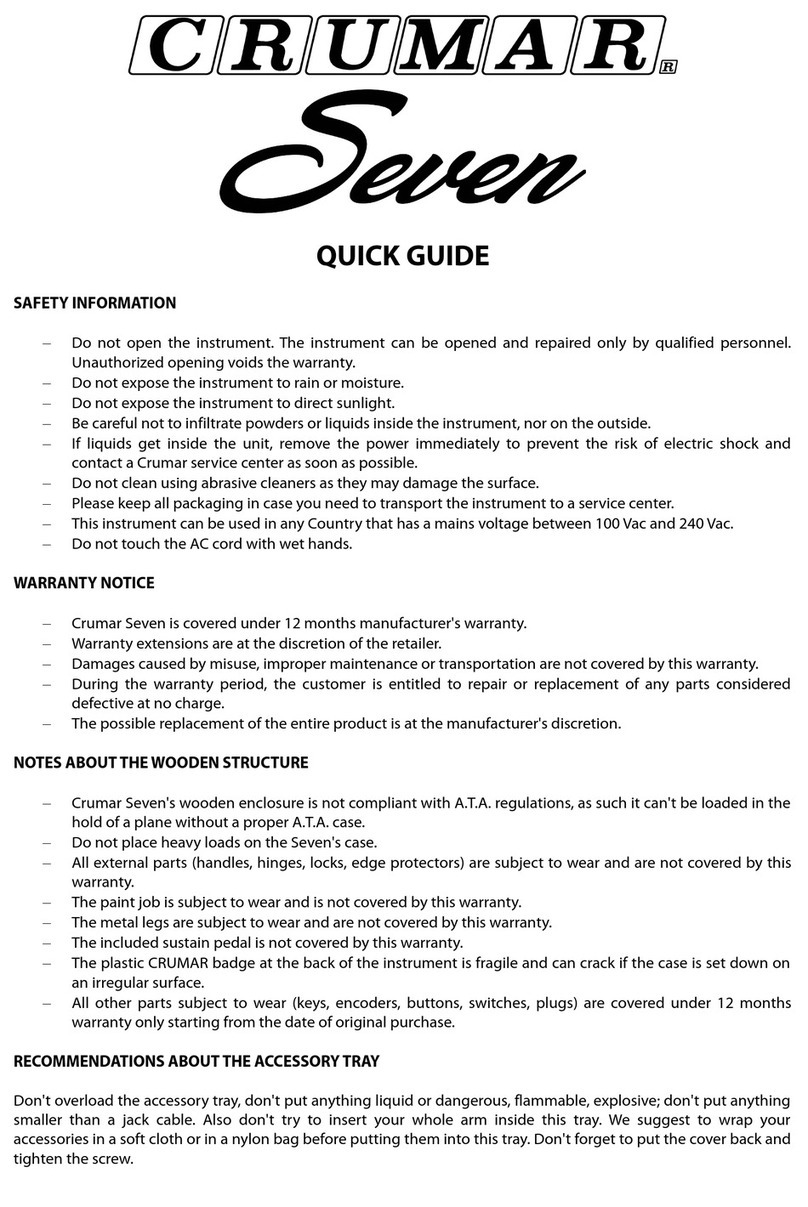
Crumar
Crumar Seven User manual
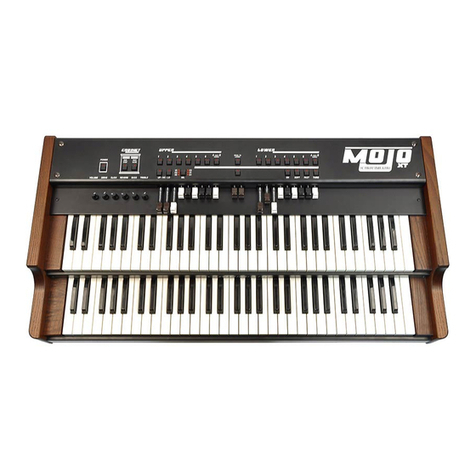
Crumar
Crumar MOJO User manual
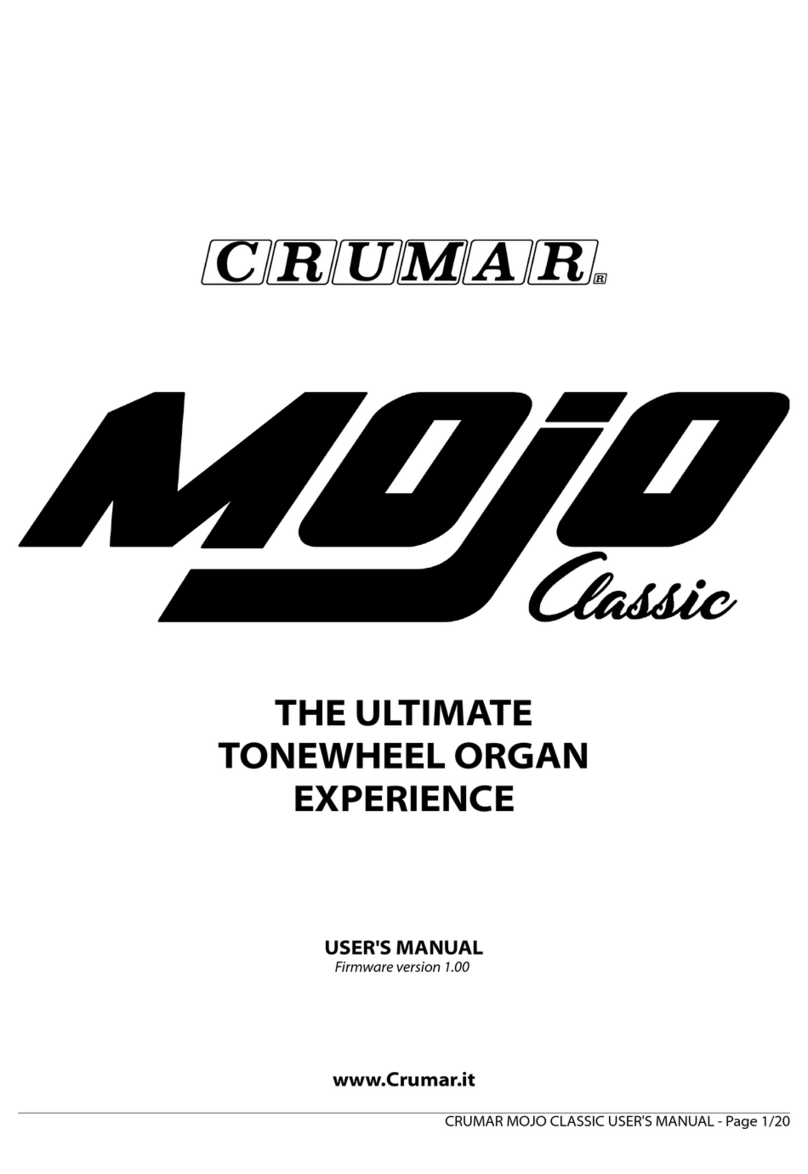
Crumar
Crumar Mojo Classic User manual
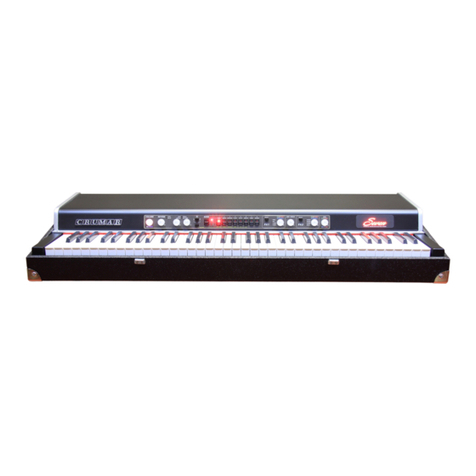
Crumar
Crumar Seven User manual

Crumar
Crumar MOJO User manual
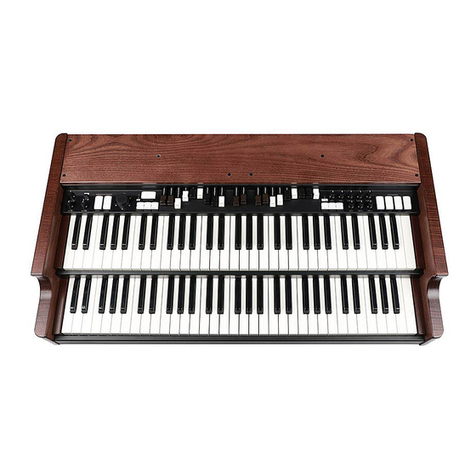
Crumar
Crumar Mojo Classic User manual

Crumar
Crumar MOJO User manual
